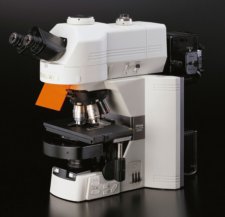Nikon Microscope Reviews
Finding the Best Model to Suit your Needs
When a company is a major manufacturer, in depth Nikon microscope reviews are needed to ensure the best end-user experience.
Founded in 1917, the Nikon Corporation’s first products were ultra-small-prism binoculars and microscopes.
After almost 100 years, Nikon microscopes remain a popular choice for education, clinical and industrial settings.
The innovative technologies developed by the Nikon Corporation include cameras, telescopes and binoculars, ophthalmologic equipment and microscopes.
Since manufacturing began in 1925, Nikon microscopes are the established benchmark for precision microscopy.
The first microscope, the JOICO, was a brass compound monocular microscope with three objective lenses and considered a technological marvel in that era.
The company remains at the technological forefront with a complete line of biological, digital and stereo models, with emphasis on adapting digital technology to optical products.
To Review: Nikon's Biological Models
Nikon dominates the bio-medical research market. You will receive a binocular and Kohler illuminated microscope with excellent optical quality.
In comparison to years past, contrast levels and the resolution are very impressive with an increased field of view.
Pricing across the microscope market has decreased over the years as well. Nikon wants to remain competitive so negotiate.
We invite you to follow the links to read further about Nikon's clinical, biological models as well as the E100 and E200 from the Eclipse series, these may be all you really need.
Eclipse 55i and the Eclipse E200
What does Nikon have to offer in these biological, upright models? Perhaps the E200 is sufficient for your needs but the higher-end research microscopes are still worth evaluating.
Optiphot, Labophot, Eclipse 50i, and E100
Do you believe that the Optiphot and Labophot microscopes are no longer relevant models for today's uses? Find out.
Also, take a look at the Eclipse 50i from the Eclipse series, these have new and amazing visual imaging systems and is the sister scope to the 55i.
Nevertheless, perhaps all you really require is the simpler, educational E100 microscope. Check out their features and capabilities and decide for yourself!
Nikon Digital Microscope Models
 Eclipse 90i from Bioon.com.cn
Eclipse 90i from Bioon.com.cnEclipse 80i and 90i Models in review
- digital imaging is making great strides and you may want to dive in and begin using a microscope with complete digital capabilities. Nikon's microscopes are robust and will not disapoint - the 80i and 90i models are great models that can digitally astound you.
Nikon Stereo Microscopes Reviews
Nikon's stereo models offer a wide-range of capabilities that can accommodate a variety of research fields.
The significant number of accessories available for stereo microscopes result in a device that can be adapted and utilized in almost any research setting to suit your needs.
SMZ1500; SMZ445 / 460; SMZ745T
- The SMZ1500 is a popular, powerful model utilized in cell and marine biology, veterinary sciences and forensic science.
- The SMZ445-460 are newer, basic models, with an ergonomic and economic designs, primarily used in plastics and gross observation.
- The SMZ745T is a trinocular model with impressive zoom, a wide-range of applications and most advanced choice for digital photomicroscopy.
Nikon Offers:
Nikon 20x Field Microscope Mini
Official Site: Nikon.com
Return from Nikon Microscope Reviews to Best Microscopes Home
Find out how to advertise on MicroscopeMaster!




